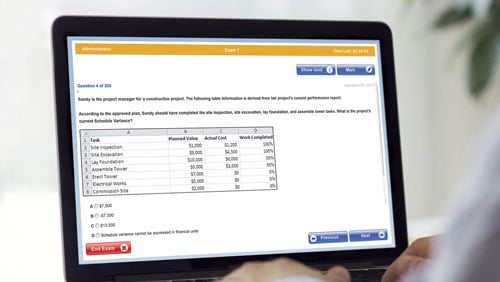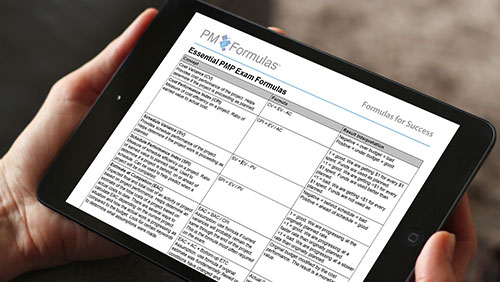The Effectiveness of Various PMP® Exam Study Techniques
 If you are just beginning or are in the middle of studying for the Project Management Professional (PMP)®, you probably already know that in order to pass, you need to fully understand both A Guide to the Project Management Body of Knowledge (PMBOK® Guide), Project Management Institute, Inc. (PMI)® and the (PMI)® Code of Ethics. You have probably spent some time thinking about the many study techniques available to you. In this article, I examine four PMP® Exam study techniques, their effectiveness, and some possible alternatives, you may not have considered.
If you are just beginning or are in the middle of studying for the Project Management Professional (PMP)®, you probably already know that in order to pass, you need to fully understand both A Guide to the Project Management Body of Knowledge (PMBOK® Guide), Project Management Institute, Inc. (PMI)® and the (PMI)® Code of Ethics. You have probably spent some time thinking about the many study techniques available to you. In this article, I examine four PMP® Exam study techniques, their effectiveness, and some possible alternatives, you may not have considered.
Technique 1 – Reading and Highlighting / Underlining the PMBOK® Guide and PMI® Code of Ethics
Reading text and highlighting or underlining as we go is a technique many of us learned and used during our high school or college days, so it is a familiar technique.
Verdict:
Studies have found that although 84% of students at elite colleges use this technique, they have also found it to be ineffective. It is kind of a security blanket, in that it makes the student feel that they are learning, but the student is actually more focused on highlighting or underlining rather than learning the concept.
Passively reading is a great first step, so don’t discount the need to read the PMBOK® Guide and PMI Code of Ethics; however, highlighting or underlining likely adds very little to your learning.
It does little to enhance understanding of the material and long term recall of the material, which makes this technique ineffective overall.
Alternatives:
Try to find other methods to learn about PMP concepts other than just reading, highlighting, or underlining them such as:
Be more active while reading. For example, ask yourself “why” a concept is relevant, or try to relate the concept to a real world example you can recall when it comes up on the PMP® Exam.
Attend a PMP Exam Prep Course so you can hear about the concepts from an instructor and learn from others in the class.
Use other tools to learn PMP concepts such as the PM Prepcast™ or another PMP Exam prep book such as “Achieve PMP Exam Success, 5th Edition: Guide for the Busy Project Manager.”
Technique 2 – Using Flashcards
Flashcards are a compact quick use study aid that typically covers one question, formula, or tidbit of information per card. This is another technique you may be familiar with from your high school or college days.
Verdict:
Spreading study sessions out over time, also known as distributed practice, has been found to enhance student performance. Flashcards provide a great method to be able to spread out learning and use the distributed practice method in a controlled and flexible way. You can easily breakdown PMP concepts into smaller “bite sized” chunks to ensure you review and master the material one concept at a time.
Flashcards have been found to be a very effective learning technique. You can pace yourself and easily use the flashcards as many times as you need in order to solidify the concepts in your mind. You can create your own from taking information out of the PMBOK® Guide or other exam prep material, or purchase premade flash cards such as PMP eFlashcards.
Technique 3 – Taking Notes on the PMBOK® Guide and PMI Code of Ethics
Taking notes is the act of write down important information while reading the material to be learned. This is another technique many of us have learned while in school.
Verdict:
Taking notes is a better technique than highlighting or underlining, but can be very time-consuming. If you use this technique wisely then it can be very effective to use while reading the PMBOK® Guide and PMI Code of Ethics. Be careful not to take notes that simply regurgitate information, or your learning will be adversely affected and taking notes would be similarly ineffective as highlighting or underlining.
Alternative 1 – Use Notes to Create Flashcards:
When taking notes, do it in a manner where you can hide terms and definitions easily. For example, create two columns on a single page where the left column contains the terms and the right column contains the definitions. Writing it out this way allows you to hide the definitions with one hand as you try to repeat them to yourself. Or you can leave a lot of extra white space that you can use to rewrite the concept later to “test” yourself.
Then you can compare what you wrote verses the note you took. Using a notebook is not as flexible as using flashcards, but you can use any notes you take as a basis for creating your own flashcards.
Alternative 2 – Use a Brain Dump:
Create a brain dump. After reading about a concept, take a sheet of paper and write down all of the details you can recall about that topic. Don’t forget to verify that the details in your brain dump are correctly recalled and that you did not miss anything.
This is an effective technique for learning a concept since you are actively filtering for the most essential information. You also end up with a way of actively recalling the information over time and most importantly you can recreate the brain dump on the day of your PMP Exam.
Technique 4 – Taking Practice Tests
Taking practice tests can include anything from testing yourself one question at a time or sitting in a quiet location and taking a full length four hour two hundred question simulated PMP Exam.
You can self-test while reading PMP related material. For example, if student A was re-reading a PMBOK® Guide chapter straight through and student B hid some text from themselves purposely as they read in order to recall the information prior to revealing the text (taking a self-imposed practice test) then student B would be more likely to recall the information long term. As student B was going through the self-imposed testing, when he failed to recall information, he simply went back to re-study the concept.
Flashcards are also a form of practice tests as each card poses a test question. Flashcards are not ideal in the sense that the format of the PMP Exam is not necessarily the same as flashcards, but are still effective. If you are looking for a PMP Exam practice test that is close to the PMP Exam, look into using the PMP Exam Simulator.
Verdict:
Practice tests are definitely recommended and studies have shown that taking practice tests is a very effective learning technique in a wide array of situations. Self-testing as you read PMP- related study material and using flashcards are both effective methods, but most effective is taking full-length timed practice PMP Exams.
Conclusion:
Not all study techniques are equally effective. For your PMP Exam preparation spend your time wisely by knowing the best study techniques. Understanding the PMBOK® Guide is fundamental to preparing for the PMP Exam, so you need to read each chapter as actively as possible and learn the concepts from a variety of resources. Practice tests and distributive practice have been found to be highly effective study techniques, so consider using flashcards and exam simulators when studying for the PMP Exam. The more active rather than passive you are in your learning the better. Create meaningful and intelligent notes, and figure out your brain dump before you decide to do any highlighting.


